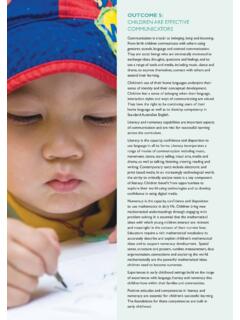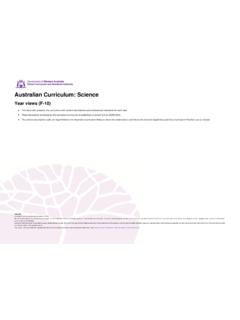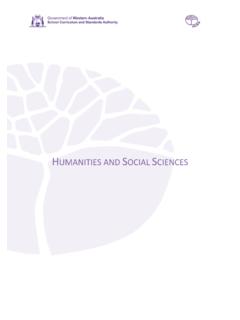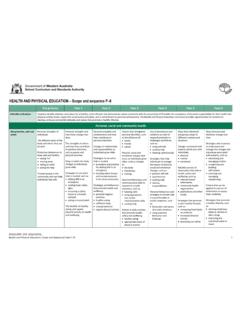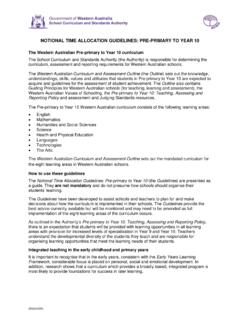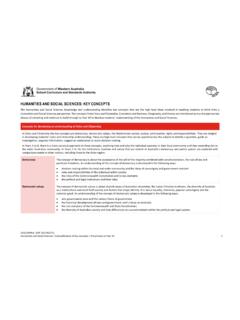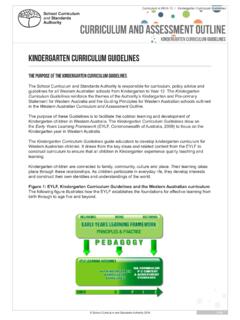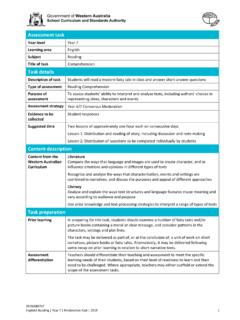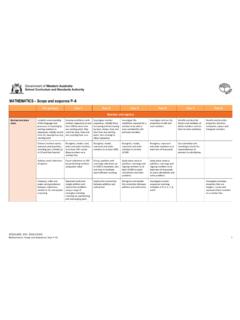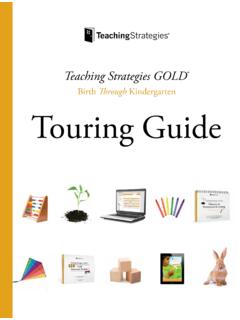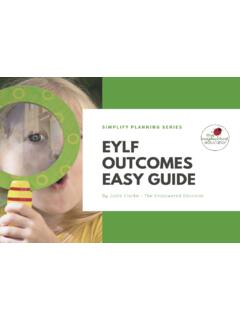Transcription of OUTCOME 3: CHILDREN HAVE A STRONG SENSE OF …
1 < < strong >STRONGstrong > >OUTCOMEstrong >STRONGstrong > > 3: < < strong >STRONGstrong > >CHILDRENstrong >STRONGstrong > > < strong >havestrong > A < strong >STRONGstrong > < < strong >STRONGstrong > >SENSEstrong >STRONGstrong > > OF wellbeing wellbeing incorporates both physical and psychological aspects and is central to belonging, being and becoming. Without a < strong >STRONGstrong > < < strong >STRONGstrong > >SENSEstrong >STRONGstrong > > of wellbeing it is diffi cult to < strong >havestrong > a < < strong >STRONGstrong > >SENSEstrong >STRONGstrong > > of belonging, to trust others and feel confi dent in being, and to optimistically engage in experiences that contribute to becoming. wellbeing includes good physical health, feelings of happiness, satisfaction and successful social functioning. It infl uences the way < < strong >STRONGstrong > >CHILDRENstrong >STRONGstrong > > interact in their environments. A < strong >STRONGstrong > < < strong >STRONGstrong > >SENSEstrong >STRONGstrong > > of wellbeing provides < < strong >STRONGstrong > >CHILDRENstrong >STRONGstrong > > with confi dence and optimism which maximise their learning potential. It encourages the development of < < strong >STRONGstrong > >CHILDRENstrong >STRONGstrong > > s innate exploratory drive, a < < strong >STRONGstrong > >SENSEstrong >STRONGstrong > > of agency and a desire to interact with responsive others.
2 wellbeing is correlated with resilience, providing < < strong >STRONGstrong > >CHILDRENstrong >STRONGstrong > > with the capacity to cope with day-to day stress and challenges. The readiness to persevere when faced with unfamiliar and challenging learning situations creates the opportunity for success and achievement. < < strong >STRONGstrong > >CHILDRENstrong >STRONGstrong > > s learning and physical development is evident through their movement patterns from physical dependence and refl ex actions at birth, to the integration of sensory, motor and cognitive systems for organised, controlled physical activity for both purpose and s wellbeing can be affected by all their experiences within and outside of their early childhood settings. To support < < strong >STRONGstrong > >CHILDRENstrong >STRONGstrong > > s learning, it is essential that educators attend to < < strong >STRONGstrong > >CHILDRENstrong >STRONGstrong > > s wellbeing by providing warm, trusting relationships, predictable and safe environments, affi rmation and respect for all aspects of their physical, emotional, social, cognitive, linguistic, creative and spiritual being.
3 By acknowledging each child s cultural and social identity, and responding sensitively to their emotional states, educators build < < strong >STRONGstrong > >CHILDRENstrong >STRONGstrong > > s confi dence, < < strong >STRONGstrong > >SENSEstrong >STRONGstrong > > of wellbeing and willingness to engage in learning. < < strong >STRONGstrong > >CHILDRENstrong >STRONGstrong > > s developing resilience and their ability to take increasing responsibility for self-help and basic health routines promote a < < strong >STRONGstrong > >SENSEstrong >STRONGstrong > > of independence and confi dence. As they experience being cared for by educators and others, they become aware of the importance of living and learning interdependently with others. Learning about healthy lifestyles, including nutrition, personal hygiene, physical fi tness, emotions and social relationships is integral to wellbeing and self-confi dence. Physical wellbeing contributes to < < strong >STRONGstrong > >CHILDRENstrong >STRONGstrong > > s ability to concentrate, cooperate and learn.
4 As < < strong >STRONGstrong > >CHILDRENstrong >STRONGstrong > > become more independent they can take greater responsibility for their health, hygiene and personal care and become mindful of their own and others safety. Routines provide opportunities for < < strong >STRONGstrong > >CHILDRENstrong >STRONGstrong > > to learn about health and safety. Good nutrition is essential to healthy living and enables < < strong >STRONGstrong > >CHILDRENstrong >STRONGstrong > > to be active participants in play. Early childhood settings provide many opportunities for < < strong >STRONGstrong > >CHILDRENstrong >STRONGstrong > > to experience a range of healthy foods and to learn about food choices from educators and other < < strong >STRONGstrong > >CHILDRENstrong >STRONGstrong > > . Physical activity and attention to fi ne and gross motor skills provide < < strong >STRONGstrong > >CHILDRENstrong >STRONGstrong > > with the foundations for their growing independence and satisfaction in being able to do things for themselves. BELONGING, BEING & BECOMING The Early Years Learning Framework for Australia 31 < < strong >STRONGstrong > >OUTCOMEstrong >STRONGstrong > > 3: < < strong >STRONGstrong > >CHILDRENstrong >STRONGstrong > > < strong >havestrong > A < strong >STRONGstrong > < < strong >STRONGstrong > >SENSEstrong >STRONGstrong > > OF WELLBEINGC hildren become < strong >STRONGstrong > in their social and emotional wellbeing < < strong >STRONGstrong > >CHILDRENstrong >STRONGstrong > > take increasing responsibility for their own health and physical wellbeing < < strong >STRONGstrong > >CHILDRENstrong >STRONGstrong > > become < strong >STRONGstrong > in their social and emotional wellbeingThis is evident, for example, when < < strong >STRONGstrong > >CHILDRENstrong >STRONGstrong > > .
5 Demonstrate trust and confi dence remain accessible to others at times of distress, confusion and frustration share humour, happiness and satisfaction seek out and accept new challenges, make new discoveries, and celebrate their own efforts and achievements and those of others increasingly co-operate and work collaboratively with othersenjoy moments of solitude recognise their individual achievement make choices, accept challenges, take considered risks, manage change and cope with frustrations and the unexpectedshow an increasing capacity to understand, self-regulate and manage their emotions in ways that refl ect the feelings and needs of othersexperience and share personal successes in learning and initiate opportunities for new learning in their home languages or Standard Australian Englishacknowledge and accept affi rmation assert their capabilities and independence while demonstrating increasing awareness of the needs and rights of othersrecognise the contributions they make to shared projects and experiencesEducators promote this learning, for example, when they.
6 Show genuine affection, understanding and respect for all < < strong >STRONGstrong > >CHILDRENstrong >STRONGstrong > > collaborate with < < strong >STRONGstrong > >CHILDRENstrong >STRONGstrong > > to document their achievements and share their successes with their families ensure that all < < strong >STRONGstrong > >CHILDRENstrong >STRONGstrong > > experience pride in their attempts and achievementspromote < < strong >STRONGstrong > >CHILDRENstrong >STRONGstrong > > s < < strong >STRONGstrong > >SENSEstrong >STRONGstrong > > of belonging, connectedness and wellbeingchallenge and support < < strong >STRONGstrong > >CHILDRENstrong >STRONGstrong > > to engage in and persevere at tasks and playbuild upon and extend < < strong >STRONGstrong > >CHILDRENstrong >STRONGstrong > > s ideas maintain high expectations of each child s capabilitiesvalue < < strong >STRONGstrong > >CHILDRENstrong >STRONGstrong > > s personal decision-making welcome < < strong >STRONGstrong > >CHILDRENstrong >STRONGstrong > > and families sharing aspects of their culture and spiritual livestalk with < < strong >STRONGstrong > >CHILDRENstrong >STRONGstrong > > about their emotions and responses to events with a view to supporting their understandings of emotional regulation and self-controlacknowledge and affi rm < < strong >STRONGstrong > >CHILDRENstrong >STRONGstrong > > s effort and growthmediate and assist < < strong >STRONGstrong > >CHILDRENstrong >STRONGstrong > > to negotiate their rights in relation to the rights of others Add your own examples from your context.
7 LEARNING OUTCOMES32 BELONGING, BEING & BECOMING The Early Years Learning Framework for AustraliaChildren take increasing responsibility for their own health and physical wellbeingThis is evident, for example, when < < strong >STRONGstrong > >CHILDRENstrong >STRONGstrong > > :recognise and communicate their bodily needs (for example, thirst, hunger, rest, comfort, physical activity)are happy, healthy, safe and connected to others engage in increasingly complex sensory- motor skills and movement patternscombine gross and fi ne motor movement and balance to achieve increasingly complex patterns of activity including dance, creative movement and dramause their sensory capabilities and dispositions with increasing integration, skill and purpose to explore and respond to their worlddemonstrate spatial awareness and orient themselves, moving around and through their environments confi dently and safelymanipulate equipment and manage tools with increasing competence and skillrespond through movement to traditional and contemporary music.
8 Dance and storytellingshow an increasing awareness of healthy lifestyles and good nutritionshow increasing independence and competence in personal hygiene, care and safety for themselves and othersshow enthusiasm for participating in physical play and negotiate play spaces to ensure the safety and wellbeing of themselves and othersEducators promote this learning, for example, when they:plan for and participate in energetic physical activity with < < strong >STRONGstrong > >CHILDRENstrong >STRONGstrong > > , including dance, drama, movement and gamesdraw on family and community experiences and expertise to include familiar games and physical activities in playprovide a wide range of tools and materials to resource < < strong >STRONGstrong > >CHILDRENstrong >STRONGstrong > > s fi ne and gross motor skillsactively support < < strong >STRONGstrong > >CHILDRENstrong >STRONGstrong > > to learn hygiene practicespromote continuity of < < strong >STRONGstrong > >CHILDRENstrong >STRONGstrong > > s personal health and hygiene by sharing ownership of routines and schedules with < < strong >STRONGstrong > >CHILDRENstrong >STRONGstrong > > , families and the communitydiscuss health and safety issues with < < strong >STRONGstrong > >CHILDRENstrong >STRONGstrong > > and involve them in developing guidelines to keep the environment safe for allengage < < strong >STRONGstrong > >CHILDRENstrong >STRONGstrong > > in experiences.
9 Conversations and routines that promote healthy lifestyles and good nutritionconsider the pace of the day within the context of the communitymodel and reinforce health, nutrition and personal hygiene practices with childrenprovide a range of active and restful experiences throughout the day and support < < strong >STRONGstrong > >CHILDRENstrong >STRONGstrong > > to make appropriate decisions regarding participationAdd your own examples from your context: < < strong >STRONGstrong > >OUTCOMEstrong >STRONGstrong > > 3: < < strong >STRONGstrong > >CHILDRENstrong >STRONGstrong > > < strong >havestrong > A < strong >STRONGstrong > < < strong >STRONGstrong > >SENSEstrong >STRONGstrong > > OF WELLBEINGLEARNING OUTCOMES
